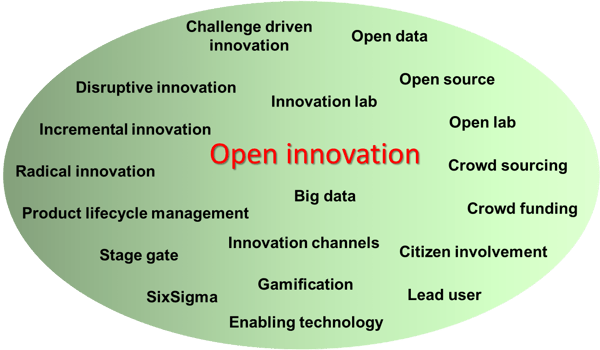Open innovation is a much debated concept initially rooted in the IT and consumer goods sector. Due to a bunch of drivers such as decreased profit margins, increasingly sophisticated regulatory environments and the general call for a participatory approach involving the main stakeholders already in early phases of R&D, open innovation becomes more and more important also in the healthcare sector. This goes along with a systematically managed opening of healthcare companies to external ideas which in turn implies a reshaping of industry-academia collaborations, the involvement of user communities along the lines of innovation processes, and changed attitudes towards the protection of intellectual property rights (companies) and the commercial exploitation of basic research (academia).

Figure. Open innovation is a concept, the implemementation of which is catalysed by new paradigms in R&D and the emergence of new enabling technologies.
Accordingly, open innovation in health care is characterised by extensive networking with a wide range of stakeholders. Also sourcing of ideas and technologies from apparently unrelated sectors, the establishment of open communication platforms, and the establishment of co-creative environments such as living labs gain in importance. The role of in-house R&D partly transforms towards guaranteeing the companys‘ absorptive capacity, i.e. its capacity to critically evaluate and utilise apparently unorthodox solutions and to maximise the benefit from knowledge generated outside the own sector.
The promising perspectives for implementing open innovation strategies have created a market for service providers in open innovation. Intermediaries like NineSigma or InnoCentive support organisations to professionalise their open innovation activities by connecting them globally to a high diversity of potential problem solvers and by giving advice about how to prepare internally for developing a culture of open innovation. They also provide guidance in the posting of challenges, the evaluation of submitted proposals, and rewarding the winning solution(s).
Clinical CROs such as Profil operate at the crossroads between preclinical research and clinical development, patent registration and scientific publication, patients and physicians, large industries and small & medium-sized enterprises (SMEs), academic institutions and regulatory authorities. In our experience clinical CROs are privileged to help their clients with taking advantage of open, collaborative & participative innovation scenarios. Clients may benefit from speeding up translational research projects and involving patients pro-actively in the setting of clinical research goals and the design of trials. Sometimes clinical CROs support SMEs with designing clinical development plans and closing out-licensing deals.
Features of open innovation
The scientific exploration of open innovation goes back to Henry Chesbrough, who defined open innovation as „a paradigm that assumes that firms can and should use external ideas as well as internal ideas, and internal and external paths to market, as the firms look to advance their technology.“ and as the „use of purposive inflows and outflows of knowledge to accelerate internal innovation, and expand the markets for external use of innovation“.
A more pragmatic description comes from Stephen Cullow who defined open innovation as being „innovation with partners to improve product pipelines and shorten time to market“. He also pointed to the important point that risks and rewards should be shared between the innovation partners.
If one agrees that real innovations should not only add value for the immediate stakeholder communities, but also rather improve the individual lives of citizens while at the same time strengthening societal sustainability, the impact of open innovation goes far beyond risk sharing and speeding-up time to market. Open innovation outcomes may create more value for multiple stakeholdes while holding the promise of increasing standards for the good of citizens and societies. By integrating participatory elements in the development of innovations for the health care sector open innovation is predestined for pushing people-centered and cost effective products and services with a demonstrated eligibility for reimbursement. This means that open innovation advances the development of products and services that elicit benefit to the health care experience of individual patients (including quality and satisfaction), increase public health, and improve the sustainability of health care systems (Triple Aim model).
In the second part of our discussion of open innovation, titled "Open innovation: what’s going on in the healthcare sector?", read about specific activities in the healthcare sector. Learn which indications see most research activities and what the future holds? Sign up on the right side for our monthly blog updates, to make sure you won't miss future posts on this topic.




